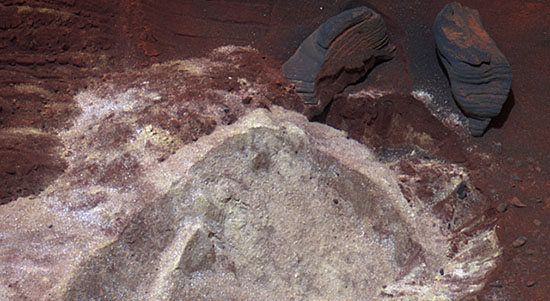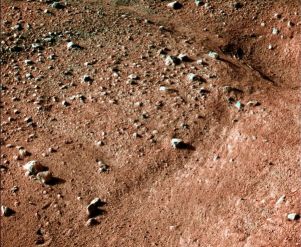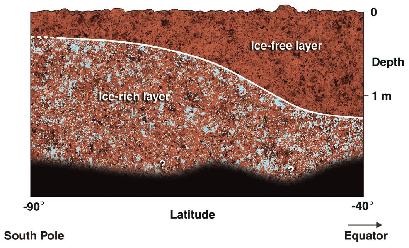![]()
Formación de Horizontes Edáficos en Marte: Casi Confirmado
Los accidentes de los vehículos que circulan por el Planeta Marte parecen ser extraordinariamente fructíferos. Ya hemos dicho que darse de bruces con el suelo es una experiencia inolvidable ¿? No nos engañemos, nadie había ideado estas plataformas móviles para detectar la posible horizonación de los suelos-regolito marcianos, aunque aquí el tropiezo generó un corte en el terreno y así aparecieron varios horizontes (de unas cuantas decenas de cm. de espesor) que, según los autores del artículo comentado, al menos algunos obedecerían al lavado (por acción del agua no hace mucho tiempo) y acumulación subsuperficial de una sal concreta. Hablamos del sulfatos de Hierro en Marte, pero también de nódulos y recubrimientos de sílice. Abajo abundaremos en los detalles que, según las noticias leídas, se mostrarán en inglés o español. De momento ya vemos que en ausencia de vida, al menos en Marte pueden detectarse suelos-regolitos que o bien muestran horizonación o bien crioturbación (suelos poligonales). Para no haberse elaborado una misión con fines edafológicos, algo es algo. Pero sigamos.

Presuntos horizontes en el suelo marciano Foto Galaxy Wire
Otros autores defienden que las partículas con recubrimiento de sílice pudieron ser producidos por eventos hidrotermales asociados al vulcanismo en ambientes ácido sulfáticos.
Curiosamente, sobre el posible lavado de sales en los suelos marcianos ya hablamos en el post “Los Suelos de Marte y sus Horizontes: Ciclos Hidrológicos, y Cambio Climático. Así pues, Roland tenía razón, al parecer. Los horizontes detectados atesoran un color amarillento debido a la hematina. No entraremos en detalles por cuanto son demasiado técnicos, mientras que los presuntos interesados sabrán más de el tema que yo. Así pues ahí os mostramos directamente las noticias relacionadas y alguna bibliografía. Esta claro, por esta última que, para quien trabaja en estos menesteres (ver al final Ray Arvidson ¡en una misma revista!) publicar a mansalva, y en un mismo año, no le resulta difícil (envidia, pero sana, que conste).
Juan José Ibáñez

Suelos Poligonales en Marte Fuente Mars NASA
La NASA halla evidencias recientes de agua filtrada en Marte
El robot de la NASA Spirit ha obtenido pruebas de que el agua, tal vez en forma de nieve derretida, corría de forma continua en el subsuelo del terreno donde se atascó el año pasado en Marte. FUENTE | El País Digital; 29/10/2010
A principios de 2008 el robot Phoenix de la Nasa tocó por primera vez hielo en la superficie de Marte. En noviembre del mismo año los científicos confirmaron la existencia de grandes glaciares ocultos bajo la superficie del planeta. Pero el gran reto era confirmar la existencia de agua.
El análisis de estos hallazgos aparece en un estudio publicado en el Journal of Geophysical Research, encabezado por Ray Arvidson, investigador de la Universidad de Washington y principal adjunto para los robots Spirit y Opportunity, que operan en Marte. El estudio se centra en las operaciones realizadas por Spirit desde finales de 2007 hasta justo antes de que el vehículo dejara de comunicarse. En abril de 2009, las ruedas izquierdas de Spirit rompieron una costra en un sitio llamado Troya quedando atrapadas en la arena blanda. Los investigadores aprovecharon para examinar con gran detalle las capas del suelo que las ruedas habían expuesto y también las superficies vecinas, logrando estos nuevos hallazgos.
PROCESO RECIENTE
Las capas de estratificación del suelo con diferentes composiciones cerca de la superficie llevaron al equipo científico del Spirit a pensar que finas láminas de agua procedentes de escarcha o nieve pudieron haberse filtrado en el terreno. «La falta de exposición en la superficie indica que la disolución de los sulfatos de hierro debe ser un proceso relativamente reciente ya que el viento ha modelado sistemáticamente el paisaje en la región que Spirit ha estado examinando», ha explicado Arvidson.
La filtración pudo haber sucedido durante los cambios climáticos cíclicos en los períodos en que Marte se muestra más inclinado sobre su eje. El agua puede haberse filtrado en la arena, llevando minerales solubles a zonas más profundas que los menos solubles. La inclinación del eje varía en escalas de tiempo de cientos de miles de años.
Los minerales relativamente insolubles cerca de la superficie incluyen lo que se piensa que es hematita, sílice y yeso. El sulfato férrico, que es más soluble, parece haber sido disuelto y arrastrado por el agua. Ninguno de estos minerales está expuesto en la superficie, que se encuentra cubierta por la arena arrastrada por el viento y el polvo.

Distribución latitudinal de permafrost en Marte Fuente: Foto Mars NASDA
Ver también: Noticia de la NASA
Según Ling y Wang (Icarus en prensa)….
These sulfates are hydrous as seen by MiniTES (Ruff et al., 2006), and could contain Fe-sulfates such as ferricopiapite, hydronium jarosite, fibroferrite, rhomboclase and paracoquimbite based on a Pancam spectral analysis (Johnson et al., 2007) and a comparison with laboratory spectra (Lane et al., 2008). According to the mineral mode analyses (Wang et al., 2006b; Yen et al., 2008), Mg- and Ca-sulfates coexist with ferric sulfates in these soils, with highly variable proportions. More importantly, Pancam spectral changes of Tyrone yellowish soils and Kit Carson yellowish soils were observed after 175 sols’ and four sols’ exposure to current martian surface atmospheric conditions (Rice et al., 2009; Wang et al., 2008a). On the basis of laboratory simulations (Freeman et al., 2009; Wang et al., 2008b), the spectral change of Tyrone yellowish soils was interpreted to be potentially caused by the dehydration, amorphization, and phase transition of ferric sulfates.
The observed status variations of ferric sulfates on Mars indicate that there is a different environment within the martian subsurface at shallow depth (tens centimeters, Wang et al., 2008a), which enable the presence and preservation of different hydrous salts from those in equilibrium with Mars’ surface atmospheric conditions.
En la página Web Galaxy Wire se dice:
In April, Spirit entered an area composed of three or more layers of soil with differing pastel hues hiding beneath a darker sand blanket. Scientists dubbed the site “Troy.” Spirit’s rotating wheels dug themselves more than hub deep at the site. The rover team has spent weeks studying Spirit’s situation and preparing a simulation of this Martian driving dilemma to test escape maneuvers using an engineering test rover at NASA’s Jet Propulsion Laboratory in Pasadena, Calif. A rock seen beneath Spirit in images from the camera on the end of the rover’s arm may be touching Spirit’s belly. Scientists believe it appears to be a loose rock not bearing the rover’s weight. While Spirit awaits extraction instructions, the rover is keeping busy examining Troy, which is next to a low plateau called Home Plate, approximately 3.2 kilometers (2 miles) southeast of where Spirit landed in January 2004.
“By serendipity, Troy is one of the most interesting places Spirit has been,” said Ray Arvidson of Washington University in St. Louis. Arvidson is deputy principal investigator for the science payloads on Spirit and its twin rover, Opportunity. “We are able here to study each layer, each different color of the interesting soils exposed by the wheels.”
Artículo al que hace referencia la noticia en español-castellano
Citation: Arvidson, R. E., et al. (2010), Spirit Mars Rover Mission: Overview and selected results from the northern Home Plate Winter Haven to the side of Scamander crater, J. Geophys. Res., 115, E00F03, doi:10.1029/2010JE003633.
This paper summarizes Spirit Rover operations in the Columbia Hills, Gusev crater, from sol 1410 (start of the third winter campaign) to sol 2169 (when extrication attempts from Troy stopped to winterize the vehicle) and provides an overview of key scientific results. The third winter campaign took advantage of parking on the northern slope of Home Plate to tilt the vehicle to track the sun and thus survive the winter season. With the onset of the spring season, Spirit began circumnavigating Home Plate on the way to volcanic constructs located to the south. Silica‐rich nodular rocks were discovered in the valley to the north of Home Plate. The inoperative right front wheel drive actuator made climbing soil‐covered slopes problematical and led to high slip conditions and extensive excavation of subsurface soils. This situation led to embedding of Spirit on the side of a shallow, 8 m wide crater in Troy, located in the valley to the west of Home Plate. Examination of the materials exposed during embedding showed that Spirit broke through a thin sulfate‐rich soil crust and became embedded in an underlying mix of sulfate and basaltic sands. The nature of the crust is consistent with dissolution and precipitation in the presence of soil water within a few centimeters of the surface. The observation that sulfate‐rich deposits in Troy and elsewhere in the Columbia Hills are just beneath the surface implies that these processes have operated on a continuing basis on Mars as landforms have been shaped by erosion and deposition.
Otros Trabajos relacionados con el tema
Correction to “Microscopy analysis of soils at the Phoenix landing site, Mars: Classification of soil particles and description of their optical and magnetic properties”; W. Goetz, et al., J. Geophys. Res., 115, E00E99, doi:10.1029/ 2010JE003717, 2010
Microscopy analysis of soils at the Phoenix landing site, Mars: Classification of soil particles and description of their optical and magnetic properties [Preview]
W. Goetz, et al., J. Geophys. Res., 115, E00E22, doi:10.1029/2009JE003437, 2010
The optical microscope onboard the Phoenix spacecraft has returned color images (4 μ m pixel −1 ) of soils that were delivered to and held on various substrates. A preliminary taxonomy of Phoenix s…
In situ analysis of ice table depth variations in the vicinity of small rocks at the Phoenix landing site [Preview]. H. G. Sizemore, M. T. Mellon, M. L. Searls, M. T. Lemmon, A. P. Zent, T. L. Heet, R. E. Arvidson, D. L. Blaney, and H. U. Séller; J. Geophys. Res., 115, E00E09, doi:10.1029/2009JE003414, 2010
Prior to the Phoenix mission, ice stability simulations predicted that surface rocks at the landing site would produce depressions in the ice table (the boundary between dry and ice‐cemented soil) i…
Silica in a Mars analog environment: Ka’u Desert, Kilauea Volcano, Hawaii [Preview]; K. D. Seelos, R. E. Arvidson, B. L. Jolliff, S. M. Chemtob, R. V. Morris, D. W. Ming, and G. A. Swayze; J. Geophys. Res., 115, E00D15, doi:10.1029/ 2009JE003347, 2010
Airborne Visible/Near Infrared Imaging Spectrometer (AVIRIS) data acquired over the Ka’u Desert are atmospherically corrected to ground reflectance and used to identify the mineralogic components of…
Early Mars hydrology: Meridiani playa deposits and the sedimentary record of Arabia Terra [Preview]; J. C. Andrews‐Hanna, M. T. Zuber, R. E. Arvidson, and S. M. Wiseman. J. Geophys. Res., 115, E06002, doi: 10.1029/ 2009 JE003485, 2010
The Meridiani Planum region of Mars has been identified as a region of past aqueous activity by a combination of orbital and in situ observations that revealed evidence for sulfate-rich dirty evapor…
Silica coatings in the Ka’u Desert, Hawaii, a Mars analog terrain: A micromorphological, spectral, chemical, and isotopic study [Preview]. S. M. Chemtob, B. L. Jolliff, G. R. Rossman, J. M. Eiler, and R. E. Arvidson., J. Geophys. Res., 115, E04001, doi:10.1029/2009JE003473, 2010
High silica materials have been observed on Mars, both from orbit by the CRISM spectrometer and in situ by the Spirit rover at Gusev Crater. These observations potentially imply a wet, geologically …
Seasonal ice cycle at the Mars Phoenix landing site: 2. Postlanding CRISM and ground observations [Preview]. S. Cull, R. E. Arvidson, R. V. Morris, M. Wolff, M. T. Mellon, and M. T. Lemmon. J. Geophys. Res., 115, E00E19, doi:10.1029/ 2009JE003410, 2010
The combination of ground observations from the Mars Phoenix Lander and orbital data from the Compact Reconnaissance Imaging Spectrometer for Mars (CRISM) provided a detailed view of the formation o…
Stratigraphy of hydrated sulfates in the sedimentary deposits of Aram Chaos, Mars [Preview]., K. A. Lichtenberg, et al., J. Geophys. Res., 115, E00D17, doi:10.1029/2009JE003353, 2010
Sedimentary deposits within the 280 km wide crater containing Aram Chaos (∼3°N, 339°E) have been differentially eroded by wind to expose a stratigraphic column 900–1000 m thick that unconformably ov…
Spirit Mars Rover Mission: Overview and selected results from the northern Home Plate Winter Haven to the side of Scamander crater [Preview] R. E. Arvidson, et al. J. Geophys. Res., 115, E00F03, doi:10.1029/2010JE003633, 2010
This paper summarizes Spirit Rover operations in the Columbia Hills, Gusev crater, from sol 1410 (start of the third winter campaign) to sol 2169 (when extrication attempts from Troy stopped to wint…
Seasonal H2O and CO2 ice cycles at the Mars Phoenix landing site: 1. Prelanding CRISM and HiRISE observations [Preview]; S. Cull, R. E. Arvidson, M. Mellon, S. Wiseman, R. Clark, T. Titus, R. V. Morris, and P. McGuire. J. Geophys. Res., 115, E00D16, doi:10.1029/2009JE003340, 2010
The condensation, evolution, and sublimation of seasonal water and carbon dioxide ices were characterized at the Mars Phoenix landing site from Martian northern midsummer to…
Spectral and stratigraphic mapping of hydrated sulfate and phyllosilicate‐bearing deposits in northern Sinus Meridiani, Mars [Preview]., S. M. Wiseman, et al. J. Geophys. Res., 115, E00D18, doi:10.1029/ 2009JE003354, 2010
We present detailed stratigraphic and spectral analyses that focus on a region in northern Sinus Meridiani located between 1°N to 5°N latitude and 3°W to 1°E longitude. Several stratigraphically dis…

[…] Formación de Horizontes Edáficos en Marte: Casi Confirmado […]
[…] “sobre los suelos de Marte y la investigación espacial”. A este siguieron otros, como la “formación de horizontes edáficos en Marte: casi confirmado” o “los suelos de Marte y sus horizontes: ciclos hidrológicos, y cambio climático. En […]
[…] en edafología. Si se pretende conocer si existió vida en otros cuerpos planetarios, como Marte, los investigadores en la ciencia del suelo tienen mucho que aportar. Cuando buscamos organismos extremófilos en las profundidades de la Tierra, no caemos en la cuenta […]